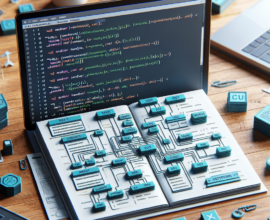Full Stack Development is the combined development of both Frontend and Backend portion of the web application. While Frontend Developers deal with only the client side of any web application and Backend Developers deal with only the server side of any web application, Full Stack Developers can design complete web applications and websites. They are capable enough of designing both the client-side and server-side portions of any web application. They can provide an end-to-end service to all their customers and their role can extend to working alongside clients during the planning phase of web-related projects. They can also be involved in projects that involve databases and building user-friendly websites.
Role of Full Stack Developer
Full Stack Development is relatively a new field which brings together the skills and knowledge for what was traditionally required for web designing and web development. The role of a web designer was to design a website whereas that of a web developer was to work on the source code. With advancements in technology and with the web growing and becoming more and more complex, these two roles of web developer and web designer have become more technical, and specialised and in some cases have even inter-linked with each other, thus giving rise to a new role of Full Stack Developer.
Roles and Responsibilities of Full Stack Developer include both Frontend and Backend responsibilities and deals with both website designing as well as website development. The roles and responsibilities of Full Stack Developer are:
- Designing user interactions on websites.
- Designing servers and databases for website functionality.
- Developing servers and databases for coding for mobile platforms.
- Developing front-end website architecture.
- Developing backend website applications.
- Ensuring cross-platform optimization for mobile phones.
- Ensuring responsiveness of applications.
- Working alongside graphic designers for web designing features.
- Designing and development of APIs.
- Seeing through a project from conception to finished product.
- Meeting both technical and consumer needs by providing an end-to-end service.
- Staying abreast of developments in website applications and programming languages.
- Handling projects involving databases and user-facing websites.
Skills and Knowledge required for becoming a Full Stack Developer
As working on either the front end or back end is getting old school, companies do prefer Web Developers who can work on both the front end and back end of a web application. They seek developers who can work on all parts of a website so that they can use the best tools for any technical problems in either part of a website. The key feature that any Full Stack Developer should possess is writing specialised code and should be skilled in most aspects of web and application development.
Full Stack Developers usually have a degree in Computer Science related fields or may have taken some programming courses. They often have degrees in programming-related fields. Full Stack Developers often start their career as Frontend or Backend developers, and once they master their skills in both ends of web development, they switch to Full Stack web Development.
The skills and knowledge that a Full Stack Developer require may vary depending on the roles and responsibilities that they are asked to handle. Typical skills of Full Stack Web Developer may include:
- Proficiency with fundamental frontend languages such as HTML, CSS and JavaScript.
- Knowledge of JavaScript frameworks such as Angular JS, React and Amber.
- Experience with server-side languages such as Python, Java, Ruby, PHP and .Net.
- Knowledge of database technology such as MySQL, Oracle and MongoDB.
- Experience with APIs such as SOAP and REST web services.
- Knowledge of Version control such as Git, CVS or SVN.
- Capability of hosting and managing any environment along with the Database administration.
- The capability of scaling applications to handle the load changes caused due to either traffic or the demanding script.
- Knowledge of Security Compliance and accessibility.
- Personal Quality Skills
- Good Analytical Thinking.
- Good Problem-Solving Skills.
- High attention to Detail.
- Excellent communication Skills.
- Teamwork is the most important skill.
- Strong organizational and project management skills.
- Qualifications of Full Stack Developer
- Degree in Computer Science or programming-related fields. Any degree with a focus on Software development skills is required.
- Internships in any Full Stack Development company while studying will add more weight to your getting hired. Also, it will provide you with relevant experience as well as guidance and mentorship from industry experts.
- Compete for course completion in any software-related field to build your specialization in one or more programming languages.
Full Stack Developer Related Programming Languages and Technologies
-
Front end
Frontend is the client side or visible part of a website or web application which deals with the user experience. The user directly interacts with the Frontend portion of the web application or website. The Frontend portion is built by using some languages, frameworks and libraries which are:- Languages
- HTML:
HTML is the abbreviation for Hyper Text Markup Language. It is used to design the Frontend portion of web pages using Markup language. HTML is a combination of Hypertext and Markup language. Hypertext defines the link between the web pages whereas Markup language is used to define the text documentation within the tag which defines the structure of web pages. - CSS:
Cascading Style Sheets is a simply designed language intended to simplify the process of making web pages presentable. CSS allows you to apply styles to web pages. More importantly, CSS enables you to do this independently of the HTML language that makes up each web page. - JavaScript:
JavaScript is a scripting language used to create the magic on the sites to make the site interactive for the user. As all the Frontend Developers need to have knowledge of any Backend language and the Backend Developers need to have knowledge of any one of the Frontend languages, this language as dealing with both ends is worth learning. It also is a great language for beginners as it is a higher-level language that also involves very little setup. It is used for enhancing the functionality of a website to running cool games and web-based software applications.
- HTML:
- Languages
-
- Frameworks and Libraries
- AngularJS:
AngularJS is mainly used to develop single-page web applications. It is a JavaScript open-source front-end framework that is a continuously growing and expanding framework which provides better ways for developing web applications. It changes the static HTML to dynamic HTML. It is an open-source project which can be freely used and changed by anyone. It extends HTML attributes with Directives, and data is bound with HTML. - React.js:
React is a declarative, efficient, and flexible JavaScript library for building user interfaces. ReactJS is an open-source, component-based Frontend library responsible only for the view layer of the application. - Bootstrap:
Bootstrap is a free and open-source tool collection for creating responsive websites and web applications. It is one of the popular HTML, CSS, and JavaScript frameworks for developing responsive, mobile-first websites. - jQuery:
jQuery is an open-source JavaScript library that simplifies the interactions between an HTML/CSS document, or more precisely the Document Object Model (DOM), and JavaScript. Elaborating on the terms, jQuery simplifies HTML document traversing and manipulation, browser event handling, DOM animations, Ajax interactions, and cross-browser JavaScript development. - SASS:
SASS is the most reliable, mature and robust CSS extension language. It is used to extend the functionality of an existing CSS of a site including everything from variables, inheritance, and nesting with ease.
- AngularJS:
- Frameworks and Libraries
-
- Some other libraries and frameworks are Semantic-UI, Foundation, Materialize, Backbone.js, Express.js, Ember.js etc.
-
Back end
Backend refers to the server-side development of any web application or website with a primary focus on how the website works. It deals with managing the database through queries and APIs by client-side commands. This type of website mainly consists of three parts front end, back end, and database. The Backend portion is built by using some libraries, frameworks, and languages which are:- Languages
- PHP:
PHP is a server-side scripting language designed specifically for web development. PHP is a dynamically typed programming language that helps developers come up with various solutions for a single problem. It also means that the same bit of code can mean different depending on the context, thus making the programs written in PHP slow to run and sometimes even tricky to scale. Since PHP code is executed on the server side it is called a server-side scripting language. - C++:
C++ is a general-purpose programming language and is widely used nowadays for competitive programming. It is also used as a Backend language. It can also be used to create operating systems, browsers, games and much more. C++ supports various different ways of programming object-oriented, functional, procedural and so on. C++ is one of the most flexible languages in the world. - Java:
Java is one of the most popular and widely used programming languages and platforms. It is one of the most versatile and flexible languages due to JVM (Java Virtual Machine). The Java Virtual Machine can run code on any computer ignoring where the program was compiled. unlike some other programming languages wherein codes created and compiled on one computer don’t run on any other computer. It is highly scalable. Java components are easily available. - Python:
This language can be used for building both web and desktop applications. The reason why Python is more popular among beginners is because this language has the simplest of syntax and is easy to understand as compared to other Backend programming languages. Python is a programming language that lets you work quickly and integrate systems more efficiently. - Node.js:
Node.js is an open-source and cross-platform runtime environment for executing JavaScript code outside of a browser. You need to remember that NodeJS is not a framework and it’s not a programming language. Most of the people are confused and understand it’s a framework or a programming language. We often use Node.js for building back-end services like APIs like website applications or mobile applications.
- PHP:
- Languages
-
- Back End Frameworks
- The list of Backend frameworks includes:
- Express,
- Django,
- Rails,
- Laravel,
- Spring etc.
- The list of Backend frameworks includes:
-
- The other Backend program/scripting languages are:
- C#,
- Ruby,
- REST,
-
GO etc.
- The other Backend program/scripting languages are:
- Back End Frameworks
-
Database
Database is the collection of inter-related data which helps in efficient insertion, retrieval and deletion of data from the database and organizes the data in the form of tables, views, schemes, reports etc.- Oracle:
Oracle database is the collection of data which is treated as a unit. The purpose of this database is to store and retrieve information related to the query. It is a database server and is used to manage information. - MongoDB:
MongoDB, the most popular NoSQL database, is an open-source document-oriented database. The term ‘NoSQL’ means non-relational. It means that MongoDB isn’t based on the table-like relational database structure but provides an altogether different mechanism for the storage and retrieval of data. - SQL:
Structured Query Language is a standard Database language which is used to create, maintain and retrieve the relational database.
- Oracle:
The Full Stack Developers are responsible for all the key roles and for ensuring the deployment of quality products. Aspiring Full Stack Developers need to have a passion for coding and need to possess all the required knowledge and skills to become an efficient Full Stack Developer. For such info do check at DockLearn.





